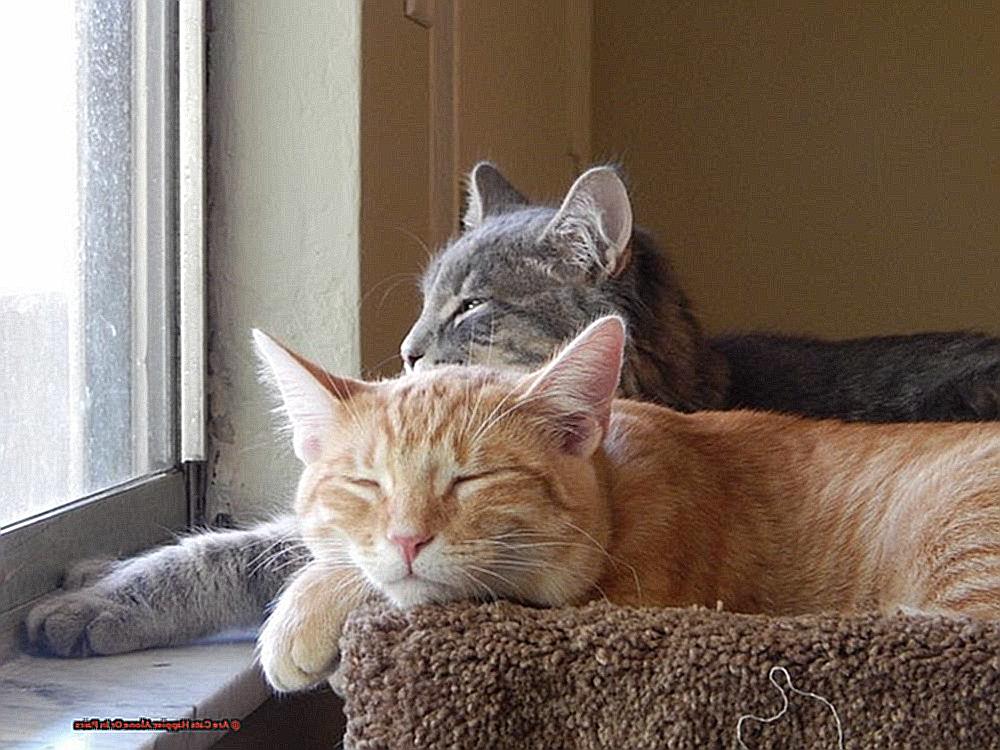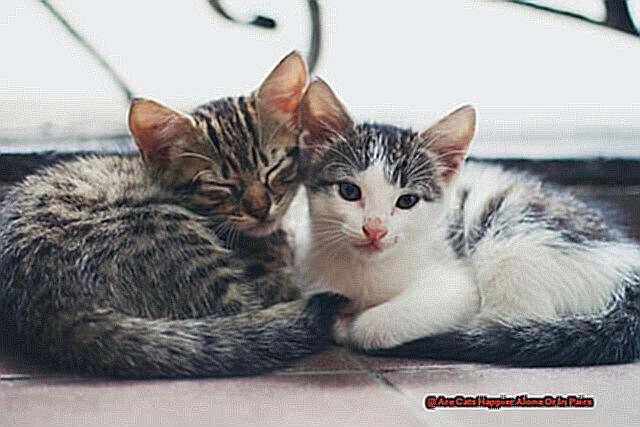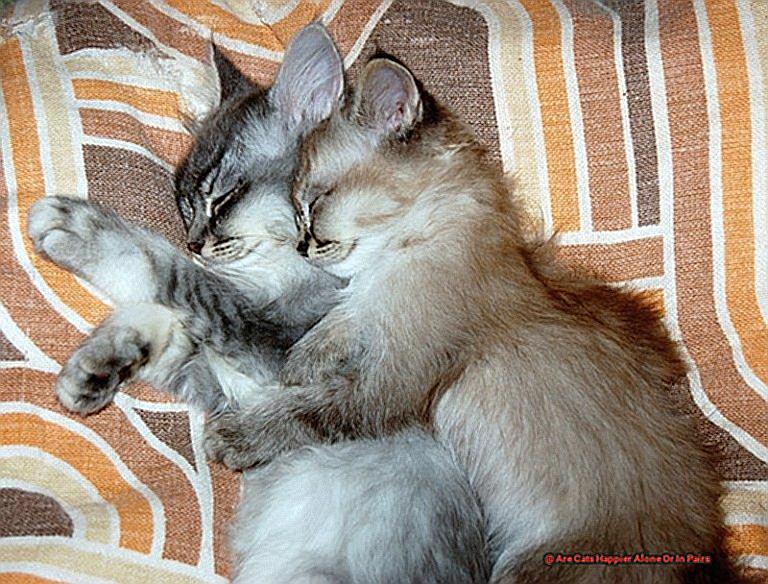Cats have been domesticated for centuries, yet their mysterious and independent nature still intrigues us.
As cat lovers, we often wonder if our furry friends are happier living solo or with a feline companion. Some say that cats are solitary creatures and prefer to be the only pet in the household, while others believe that having a feline friend can greatly enrich their lives.
So, what’s the truth? Do cats truly thrive alone or do they need a buddy by their side?
Get ready to discover whether your cat is truly content flying solo or if they secretly crave some company.
Are Cats Happier Alone Or In Pairs?
Contents
Personality plays a significant role in a cat’s happiness when living alone. Just like humans, cats have different temperaments and preferences. Some cats may be perfectly content being the only feline in the house, while others may become lonely and bored without a companion. It’s essential to observe your cat’s behavior and see if they show signs of loneliness, such as excessive meowing or destructive behavior.
Age is another crucial factor to consider. Kittens, for example, are highly social creatures and often do better when raised with another kitten or cat. They can learn crucial social skills and engage in playtime with their feline friend. On the other hand, senior cats may not have as much energy to play and interact with another cat and may prefer a quieter environment.
The living environment also plays a role in a cat’s happiness when living alone. Indoor cats who do not have access to outdoor stimulation may benefit from having a companion to keep them company and engaged. On the other hand, outdoor cats who have plenty of space and stimulation may not necessarily need a feline companion.
Socialization is another crucial aspect to consider. If a cat has been socialized with other cats from a young age, they may be more comfortable and happy living with another feline. However, if they have not had much exposure to other cats, they may struggle with sharing their space and resources.
But what about their human family? It’s important to note that just because a cat is living alone does not mean they are completely isolated. As social creatures, cats still need human interaction and companionship. So even if a cat is an only pet, their human family can still provide the socialization and stimulation they need to thrive.

Ultimately, whether a cat is happier alone or in pairs depends on their individual personality, age, living environment, and socialization. As responsible owners, it’s up to us to observe our cats’ behavior and preferences and provide them with the proper companionship and socialization they need to live happy and fulfilling lives.
The Impact of Socialization on a Cat’s Happiness
In this blog post, we will explore the impact of socialization on cats and the importance of considering their individual personalities before introducing a new feline companion.
Socialization is the process of interacting and bonding with other cats or humans. For cats, this begins at a young age when they are exposed to different people, animals, and environments. Proper socialization during this critical period can greatly influence a cat’s behavior and overall well-being as an adult.
Kittens who are exposed to positive socialization from a young age tend to be more well-adjusted and happy as adult cats. They are more confident, less fearful, and have better social skills. This is because they have learned how to communicate and interact with others in a healthy way.
On the other hand, cats who lack proper socialization may develop behavior problems such as aggression, fearfulness, and anxiety. They may have difficulty adjusting to new situations or interacting with others, making it challenging for them to form meaningful relationships. This can lead to a decrease in overall happiness and quality of life for these cats.
Companionship for cats
Having a companion can provide a sense of security and comfort for cats, especially if they were separated from their littermates at a young age. It can also prevent loneliness and boredom when their owners are away. However, it is important to note that not all cats need or want a feline companion. Some may form strong bonds with their human owners and may not require another cat for happiness.
Introducing a new companion
If you do decide to add another cat to your household, it is crucial to consider the individual personalities of both cats. Proper introduction and bonding techniques are necessary to ensure a smooth transition and prevent tension and aggression between the two cats.
Benefits of Having a Companion Cat
Owning a cat can bring unconditional love and companionship to your life. Having a feline friend can also bring health benefits, helping to relieve stress and improve your heart health. Let’s explore the benefits of having a companion cat:
Social Stimulation and Reducing Boredom
Cats are social animals, and contrary to popular belief, they enjoy the company of other felines. Studies have shown that cats form strong bonds with other cats and have a complex social hierarchy. Having a companion cat can provide mental stimulation and reduce boredom for both cats, especially for those who spend most of their time indoors.
Alleviating Separation Anxiety and Providing Security
We all know how much our cats love us, but they can also experience separation anxiety when we’re away. Having another cat as a companion can help alleviate this anxiety and provide a sense of security for your feline when you’re not around. Knowing that they have a friend to keep them company can give them peace of mind and prevent destructive behavior.
Engaging in Play and Grooming Together
Companion cats can engage in play and grooming together, which is not only fun but also beneficial for their physical health and hygiene. Playing with each other can provide exercise and help maintain good hygiene through grooming sessions.
Reducing the Risk of Behavior Problems
In multi-cat households, having a companion cat can reduce the risk of behavior problems such as aggression or destructive behavior. This is because cats have a natural inclination towards hunting and playing, and having another cat to engage in these activities with can prevent them from taking out their energy on furniture or other household items.
Improving Overall Mood and Wellbeing
Believe it or not, having a companion cat can even improve the overall mood and wellbeing of a solitary cat. This is especially true for senior cats who may become more active and sociable when introduced to a new feline friend. It’s heartwarming to see how a new companion can bring so much joy and happiness to our beloved cats.
Factors That Affect a Cat’s Preference for Living Alone or in Pairs
Cats are independent creatures, but they can also be social animals. Just like humans, cats have their own unique preferences and personalities. Some cats thrive on being the only feline in the household, while others enjoy the company of a companion cat. In this section, we will explore the various factors that can influence a cat’s preference for living alone or with a companion.
- Socialization: A cat’s level of socialization can greatly affect their preference for living alone or in pairs. Cats that have been socialized from a young age may feel more comfortable living with other cats and may even benefit from the companionship. However, cats that have not been socialized properly may exhibit territorial behavior and prefer to live alone.
- Age: The age at which a cat is introduced to living with other cats can also play a role in their preference for solitude or companionship. Cats that are raised in a multi-cat household from a young age tend to adapt well to living with others. On the other hand, older cats who have always lived alone may struggle to adjust to sharing their space.
- Territory: Cats are territorial animals and may feel more comfortable being the only cat in their home. This is especially true for cats that have been previously abandoned or have had negative experiences with other cats in the past. They may prefer to have their own space and resources without having to compete with another cat.
- Personality: Just like humans, cats have unique personalities and preferences. Some cats are more outgoing and social, while others are more reserved and prefer to keep to themselves. These personality traits can greatly influence a cat’s happiness living alone or in pairs. For example, an outgoing cat may benefit from having a companion to play and interact with, while a shy cat may feel overwhelmed by the presence of another cat.
- Health: A cat’s health can also affect their preference for living alone or with other cats. Cats with chronic illnesses or disabilities may require more attention and may feel overwhelmed by the presence of another cat. On the other hand, healthy cats may benefit from the companionship of another feline friend.
Signs of a Happy Cat
Unlike dogs, whose tail-wagging and enthusiastic demeanor make it obvious when they’re happy, cats can be a bit more subtle in showing their emotions. As an expert on the topic, I have observed and researched the various signs that can indicate a cat’s happiness.
So, let’s take a closer look at some of the ways your cat’s coat, appetite, sleep schedule, social behavior, and body language can reveal their contentment.
A Shiny Coat = A Happy Cat
Cats are famous for their grooming habits, and a healthy and shiny coat is a clear indication that your feline friend is content and relaxed. Regular grooming not only keeps their coat clean and free of tangles but also promotes blood circulation and distributes natural oils, resulting in a lustrous and healthy coat. On the other hand, if your cat’s coat appears dull and unkempt, it could be a sign of stress or unhappiness.
A Healthy Appetite
A happy cat will have a healthy appetite and will eagerly eat their meals. However, if your cat suddenly loses interest in food or stops eating altogether, it could be a sign of stress or illness. It is essential to monitor your cat’s eating habits and consult with a veterinarian if you notice any significant changes in their appetite.
Playful and Curious Nature
Cats are curious creatures who love to explore their surroundings. A happy cat will have a playful and curious nature, engaging in activities such as chasing toys or investigating new objects in their environment. If your cat is happily playing and exploring, it shows that they are content and satisfied with their surroundings.
Consistent Sleep Schedule

Cats are known for their napping habits, but a happy cat will have a consistent sleep schedule without any sudden changes in their sleeping habits. If your cat is getting enough rest and relaxation, it is a good sign that they are in a peaceful and comfortable environment.
How to Introduce Cats to Each Other
The thought of introducing your current cat to a new one can be daunting. Will they get along? Will they fight? These are valid concerns, but with the right approach and mindset, introducing cats to each other can be a smooth and successful process.
The key to a successful introduction is patience and taking your time. Rushing the process can lead to stress and aggression for both cats. As an expert on introducing cats to each other, I have learned through personal experience and research that following a step-by-step approach is crucial for a harmonious relationship between feline companions.
The first step is to keep the new cat separated in their own room for a period of time. This allows them to get used to each other’s scents without any direct contact. It is essential to provide the new cat with their own food, water, and litter box in this separate space.
Next, start feeding the cats on opposite sides of a closed door. This creates a positive association between each other’s presence and something they both love – food. After a few days of this, you can start opening the door slightly so they can see each other while they eat. If there are any signs of aggression or tension, go back to feeding them on opposite sides of the door until they are calm again.
The next step is to allow supervised short interactions between the cats, always keeping one cat on a leash for safety. This will help them get used to each other’s presence without any physical harm. If there are any signs of aggression during these interactions, separate the cats and try again later. It is crucial not to force interactions or let them escalate into fights.
Gradually increase the length of these supervised interactions until you feel comfortable leaving the cats together unsupervised. Remember, every cat is different, and some may take longer to adjust to a new cat in their territory. Be patient and go at their own pace.
It is also important to provide each cat with their own resources, such as food bowls, litter boxes, and toys. This prevents competition and potential conflicts between the cats. It is vital to give each cat their space and avoid creating an atmosphere of competition or tension.
Overall, introducing cats to each other requires patience, consistency, and careful observation. By following these steps, you can help create a harmonious relationship between your cats and ensure they are both happy and comfortable in their new living situation. However, keep in mind that every cat is unique and may have their own preferences and needs. If you encounter any persistent issues or signs of aggression, seeking professional advice from a behaviorist can help assess the situation and provide guidance on how to proceed.
Addressing Common Concerns About Multi-Cat Households
Many cat owners worry that their cat may be lonely or depressed if they are the only cat in the household. However, studies have shown that cats are content living on their own. In fact, many cats prefer to have their own space and may become stressed out if they have to share it with another cat. It’s important to remember that every cat is unique and has different needs, so it’s important to observe your cat’s behavior and make a decision based on their individual preferences.
Solution: Pay attention to your cat’s behavior and provide plenty of attention and playtime.
While cats may not necessarily need another cat to fulfill their social needs, they still require attention and playtime from their owners. Make sure to spend quality time with your cat every day, engaging in activities such as interactive play and grooming. This will help prevent boredom and keep your cat happy and fulfilled.
Myth: Multiple cats means more fights and territorial issues.
It’s a common misconception that having multiple cats will result in constant fighting and territorial issues. While conflicts can happen, it’s not always the case. Cats living in the same household can form strong bonds and often enjoy each other’s company. To minimize any potential conflicts, it’s important to introduce new cats slowly and properly. This includes providing separate spaces for each cat, gradual introductions through scent swapping, and supervised interactions.
Solution: Properly introduce new cats and provide plenty of resources.
To ensure a peaceful coexistence between multiple cats, it’s important to provide enough resources for each cat. This includes separate food and water bowls, litter boxes, and resting areas. Cats are naturally territorial animals, so having their own designated space can help prevent any potential conflicts.
Myth: Owning multiple cats is too expensive.
While it’s true that owning multiple cats means more expenses for food, litter, and veterinary care, it’s important to consider the benefits as well. Having two or more cats can actually save money in the long run as they provide each other with companionship and entertainment. Plus, many cat owners find it rewarding to see their cats interact and play together.
Conclusion
After diving into the age-old debate of whether cats are happier alone or in pairs, it’s clear that there is no one-size-fits-all answer. As cat lovers, we know that our feline friends possess a certain level of independence and mystery that keeps us endlessly fascinated.
Through this exploration, we have uncovered key factors that can influence a cat’s happiness when living solo or with a furry companion. From personality and age to living environment and socialization, each cat has unique needs and preferences that should be taken into consideration.
As responsible owners, it is our duty to observe our cats’ behavior and provide them with the proper companionship and socialization they need to thrive. While some may argue that owning multiple cats can be costly, the benefits of companionship and entertainment they bring to each other cannot be overlooked.
We’ve also debunked common myths surrounding multi-cat households and addressed concerns such as loneliness and territorial issues. It’s important to remember that every cat is an individual with their own quirks and preferences – just like us humans.
In the end, whether your cat prefers flying solo or having a feline friend by their side, one thing is for certain – they hold a special place in our hearts as beloved companions. So let’s continue to shower them with love and attention, while also respecting their unique personalities and needs.






